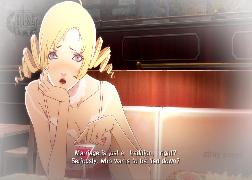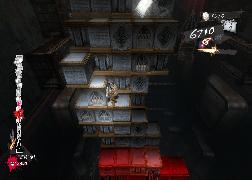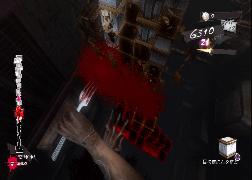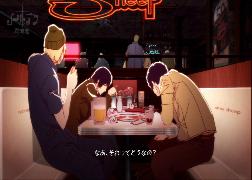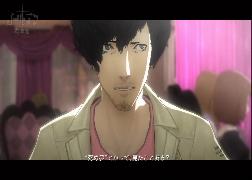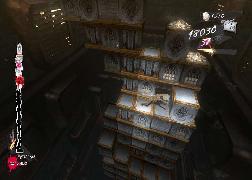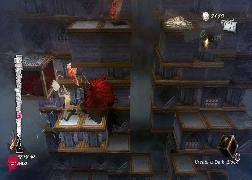Platforms: Xbox360, PS3
Release Date: 2011-07-26
Regions: USA Japan
Chris’s Rating: ★★★★
A thriller with sex, curses, and… block puzzles? Catherine is one of the most innovative and difficult-to-catagorize games ever.
Though this site has cataloged many horror games, most fall into one of a few distinct categories. You’ve got your exploration / puzzle games (in first or third person), your action games, a couple of stealth games and the occasional brawler. Throw in an adventure game or two and you can account for almost every horror game ever made.
Except for Catherine. Catherine defies categorization; it is unlike any game I’ve played before, horror or otherwise, in both theme and play style. It’s certainly a horror game, but the brand of horror it has to offer is a unique blend of fear-that-my-secret-will-be-revealed and insane, ego-crushing difficulty. It’s an adventure game with no exploration, a puzzle game with a significant story. It plays with sex, relationships, the emotional significance of marriage and adultery, and will even teach you a fair bit about various alcoholic drinks. Catherine is a weird, difficult, fascinating, and stressful game; I don’t think there’s ever been a title quite like it to date.
Vincent is a 30 year old programmer who spends most nights drinking with his friends at the Stray Sheep bar. He’s been going out with Katherine for five years, and lately she’s been hinting (read: threatening) that the next step in their relationship is marriage. Vincent isn’t ready for such a big commitment; “What’s wrong with our relationship the way it is?” he asks. He loves Katherine, or at least he says he does, but he can’t bring himself to actually consider the possibility of marriage. For the moment, his approach to the problem seems to be to drink it away.
His situation takes a dramatic turn for the worse when, after getting particularly hammered one night, Vincent wakes to find a strange girl naked in his bed beside him. His memory from the night before is hazy, but he gathers that he met the new girl, named Catherine, at the bar and eventually took her home. Catherine is the polar opposite of Katherine; she is young, athletic, blonde, fun-loving, and quite cute. Despite her good looks and apparently intense interest in Vincent, her presence is terrifying: Vincent realizes he’s cheated on Katherine, and if she finds out it will be the end of their relationship. Catherine, for her part, lets him know that if she ever found out that he was seeing other girls, she’d kill him (and the way she says it, sitting on his chest and tracing a line down his bare sternum, he’s not quite sure if she’s joking).
Vincent tries and fails to break his new relationship off. In the mean time, his primary goal is to ensure that Katherine and Catherine never find out about each other. The news is full of stories of men found dead in their beds, and the rumor mill suggests that these men were cursed by women they had wronged. At the same time, Vincent has a series of nightmares involving sheep, an endless staircase, and Katherine. He can’t quite remember the details in the morning, but he knows something is going on. I mean, above and beyond his problem with his girlfriends.
Catherine has a long and interesting story. The bits I’ve covered here account for the first hour or two of play; things continually worsen for Vincent over the course of the game, but there are some twists and turns along the way that I didn’t expect. The story is told through dialog, mostly in-game with an occasional cut scene, and the writing and voice acting is great (I played the Japanese version). The art and presentation is also top-notch. Catherine sports one of the best toon shaders I’ve every seen; it perfectly captures the manga chic art style upon which the game is based. Oh, and the sound, particularly the music, is similarly high end.
But it’s the story that provides the incentive to keep playing; though the game itself is fun and the production values high, the main reason to complete Catherine is to find out what happens to Vincent. The story is so well told and the characters so interesting that I was willing to work really hard to see the game through to its conclusion.
Now that I’ve spent so much time talking about story, it might surprise you to learn that Catherine is mostly a block puzzle game. Each night Vincent has a nightmare that constitutes the main component of the game: scaling a large tower made of blocks that he can move around to create a path. Blocks can be pushed or pulled, will stick to adjacent blocks and sometimes have odd properties (there are blocks that crumble, blocks that explode, slippery blocks, etc). The bottom of the tower is falling apart–the blocks float in space over a giant abyss–and so Vincent must constantly ascend in order to survive.
The block puzzle parts of the game are hard. I mean, really hard. Atlus released a patch shortly after Catherine went on sale that made it slightly easier (continue items give you two continues instead of one), but even with the patch the game is neigh impossible. You will die in this game, over and over again, on the same level, sometimes for days on end. It was not uncommon for me to die 50 or more times on a single level towards the end of Catherine; we’re talking about sections that take several hours to complete with no save points on the way. The block puzzle mechanics are smart and the puzzles are fun, but goddamn, the game is hard.
The other significant mode in Catherine is the Stray Sheep mode. In this mode the player can control Vincent as he drinks with his friends, checks his e-mail on his phone, and walks around the Stray Sheep bar. This is where much of the story exposition occurs, and it’s the “Adventurey” part of the experience. The best part about Stray Sheep mode is that Vincent can send and receive e-mail from Katherine and Catherine on his phone. The phone writing interface is genius: it lets you compose messages from a collection of options for each line (the options change with every mail), and your goal is to write the message such that Catherine (or, more often, Katherine) doesn’t get angry. This system completely captures the stress of trying to write a carefully-worded but highly political e-mail. It’s one of the best parts of the game because it puts you right in Vincent’s shoes and makes you feel like an accomplice to his adultery. It’s possible to purposefully write these messages like a jerk, and apparently if you act like a jerk throughout the whole game the ending changes. But given the setup I suspect few people will do that; they’ll act the way Vincent wants to act, which is desperately to placate his suspicious girlfriend and simultaneously rid himself of his unintentional lover without provoking an attack.
I have a few issues with the game, almost all of which have to do with the block puzzle mode.
The first problem is a big one: the controls are not tight enough. That’s not to say that the controls are loose; on the contrary, they are wound so tight that you’ll play with the d-pad rather than the analog sticks. But even highly responsive controls are not enough for the level of difficulty Catherine asks of its players. Specifically, the game fails to parse the difference between “turn around” and “turn around and go forward” way, way too often. Many times turning around will result in unintended movement, and in a game where a single misstep can cost you the level, that really sucks. I thought at first that I just wasn’t being precise enough, and that the problem would go away as my muscle memory improved, but this didn’t actually happen: I was unintentionally running all the way up until the very last level.
The game play in the block mode has to do with moving blocks. It must be done very quickly or Vincent will fall to his death. However, a single wrong move generally dooms the player. Part of Catherine’s intense difficulty is that there’s no undo, no way to go back and revert an unintended move. Combine that with not-good-enough controls and you have a recipe for frustration. I cannot count the number of times I accidentally pushed a block when I intended to pull it, or jumped onto spikes when I only intended to face them. It happened to me in every level, in every play session. Games that are this hard can’t have ANY issues with the controls, or the difficulty becomes arbitrary and frustrating.
The other major problem with the block mode is the checkpoint system. Levels have checkpoints, but towards the end of the game there are very few. In the last couple of levels you’ll reach the one and only checkpoint very early in the tower (in the first 5th, usually). Since one wrong move can screw you in this game, the way to progress up the tower is to try something, fail, restart, try something different, succeed, go to the next section, try something, fail, restart, etc. What happens in practice is that you keep doing the same actions over and over and over again, making tiny amounts of incremental progress as you attempt to memorize each section of the tower. You’ll find yourself completing the puzzle areas immediately after the checkpoint again and again–20 tries, 40 tries, 60 tries later. At that point the puzzles hold no value; you know how to complete them and are in no danger of failing, so they become a route chore. The game would have been much better if there were more checkpoints so that you don’t have to repeat the same ten puzzle areas for each and every failure.
Despite a few flaws and the thumb-agony difficulty, Catherine remains an absolutely fascinating game. It’s challenging, both as a game and to you, the player. It asks difficult questions like “what is the value of marriage?” “is it cheating if you were drunk?” and “which is better: a complex long-term relationship or strings-free casual sex?” And when I say asks, it literally asks: at the end of each level Vincent is quizzed on his position on life, relationships, and love. The game then gives you an Everybody Votes-style breakdown of what all the other players said. This is ground not frequently trodden by video games, and almost never at this level of quality. The story is interesting partially because it plays with sexual imagery while simultaneously dealing with these sorts of sticky commitment questions. When Catherine appeared naked in Vincent’s bed my emotional response was increased stress rather than titillation; the game already had me under its control and was able to work its emotional levers as it saw fit (note that Catherine has no real nudity, but it’s a bit racy nonetheless).
The goal of a good horror game is to suck the player in and then apply stress to their psyche. Catherine does this wonderfully, in ways I’ve never seen before. It’s one of the hardest games I’ve ever played, and it’s not without a few flaws, but even so it’s one of the best games I’ve played for the Quest.

